|
Hasegawa's 1/48 scale
Kawasaki Ki-61-I
Hien
by Fernando Rolandelli
|
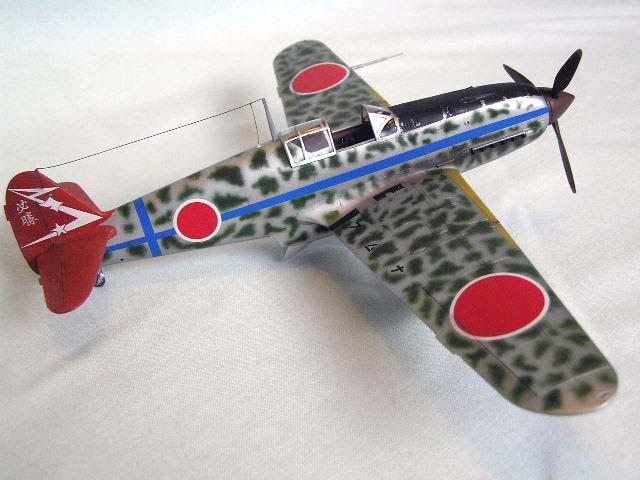
|
|
Kawasaki Ki-61-I Hien
(Tony) |

Hasegawa's 1/48 scale Ki-61-I Koh/Otsu Hien is available online from
Squadron.com
Background
A “multipurpose” fighter developed alongside the heavy interceptor
Ki.60 around the license-built Daimler Benz DB 601 power plant, the Hien
has the distinction of being the only Japanese fighter with an in-line
engine, thus provoking all sorts of misidentifications and the
appearance of “recognition” markings in Allied fighters.
The story of its nickname “Tony” being assigned on the assumption that
it was an Italian design is probably true but not at all that
exceptional, as most Japanese aircraft designs were regarded as mere
copies of Western equipment (in fact they were, up to the early 1930s,
and many Army weapons still were in WWII), and the obvious difference of
Hien to the rest of them (as well as its superficial similarity to the
Mc.202) pretty well justifies that.
A good aircraft providing adequate armament and some measure of
protection, it was hampered by an unreliable power plant (Japanese
engineers never coped with in-line engines, even with a rock-steady one
like the DB), leading to the development of the Ki.100 Goshikisen.
However, it was a serious contender up to the appearance of the P-51D.
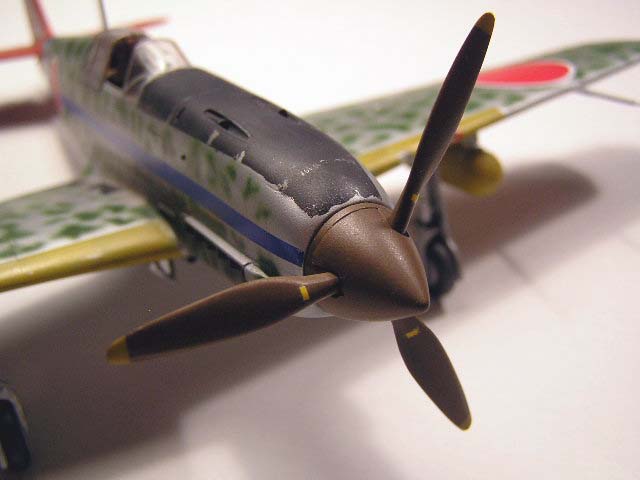
Maj. Teruhiko Kobayashi started his career as an Army officer in the
Artillery branch, later transferring to light bombers, serving in 45th
and 66th Sentais. Further transferring into fighters, he served in the
Akeno fighter school, being appointed Group Commander of the 244th
Sentai. A home defence group, based at Chofu airfield in the outskirts
of Tokyo, this was as much a crack outfit as a highly publicized unit,
whose exploits were exaggerated to the most to boost morale. It has been
said that this very machine was especially prepared for a session of
propaganda photos and not flown operationally, at least as depicted. A
share of the mighty B-29 was brought down by the unit; however, the
personal account of Kobayashi was trimmed down from a dozen (ten B-29s
and two fighters, taken mostly from his own accounts as well as from
pictures of this very machine –maybe it showed the unit’s successes, in
true Japanese IAAF tradition) to just five, three B-29s and two Hellcats
(one of the former reportedly by ramming; in any case, no small feat).
Rejoining the JSDF after the war, he got killed at the commands of a
T-33 in 1953 in a flying accident.
Hasegawa's 1/48 scale Hien
This 1/48 scale kit is the Hasegawa, in the markings of the 244th
Sentai. No detailing set was used, exception made of the seatbelts, from
Eduard 49 005, and the small ring sight, from Eduard 48 411. The
customary Squadron vac canopy was added. After a search for suitable
decals (more on that later) I ended up using Techmod 244th Sentai sheet.
The kit is good, though not without its shape issues (me, a rivet
counter?) Though undoubtedly a “long fuselage” Hien, it lacks a couple
of millimeters, all of them seemingly in the nose area. Common
occurrence in the Hase’s stash, it seems. Wheel wells are far too
shallow, and next to impossible to fix. Canopy is exceedingly thin, but
moulded one piece. Lastly, the moulds may be a bit worn out, and most
large pieces showed warping to some extent.
The Cockpit
Well, the cockpit is actually quite good, as most Hase’s Japanese
planes in the scale. However, and also as usual, it is oversimplified in
the deck area forward of the instrument panel. There was no bulkhead
there, so I deleted the one in the kit and scratchbuilt a “shelf” to
which I added the butts of the forward guns. I scratchbuilt them from
simple plastic square section rods, but any .5 Browning butt could be
used, Ho-20 cannons were simply overfed versions of these. The reflector
sight mounting was extensively rebuilt, and the small auxiliary ring
sight was added.
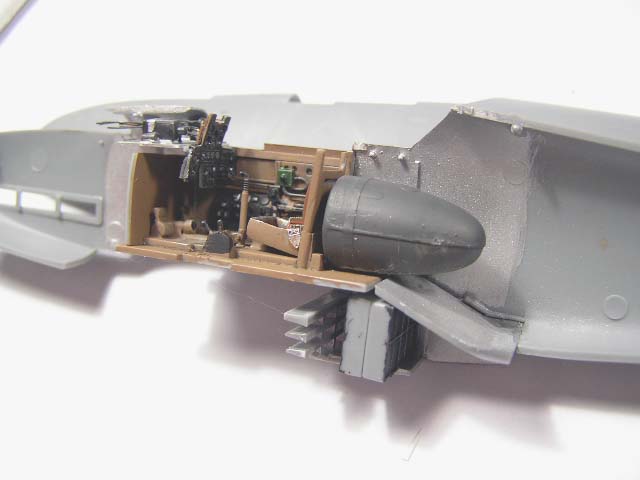
The instrument panel was thinned to scale and the butts of the upper
row of instruments and corresponding wiring was added. The sidewalls and
especially the floor were further detailed with additional fittings,
piping and wiring. Hien’s main fuel tank was visible behind the pilot’s
seat, so I mimicked one from half a 109 drop tank (dozens of these in
any self-respectful spare parts box).
Fuselage
This being a reissue of an earlier released kit, it seems that age is
showing in the moulds, and most large parts were moderately warped. The
curvature of upper wings had to be restored with some plugs, and huge
gaps in the wing root leading edges filled.
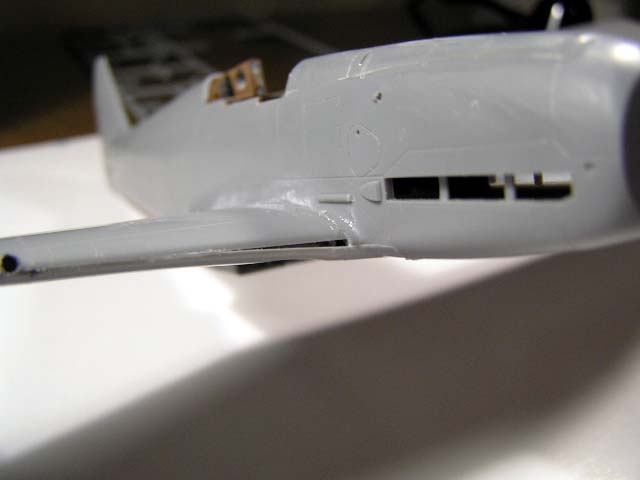
A droop in the right wing had to be addressed by means of violence
and cyano. Gun muzzles were added inside the gun ports and some
structural detail to the tail wheel well. In any event, all proceeded
quite smoothly!
Interior
Conventional wisdom says that Hiens’ interiors were painted a Sand
Earth colour. Mikesh argues that, but can only provide as evidence the
interior of the Ki.100 in the Cosford collection, reportedly a model
restoration, which has been painted mostly in the exterior Dark Green.
Some people have claimed to actually possess some Hien’s cockpit small
parts, reporting them to be as sandy earth as can be. Therefore, I tried
to match the Light Earth color sample in Mikesh’s, and decided that FS
30219 should be pretty close (he admits the colour to be found in the
structure below the actual floor in the Ki.100, which was enough for
me). Any one would work, but I used Polly Scale acrylic.
Exterior
Well, I usually shun from building “ace’s mounts”, so I wanted as
discreet a Hien as possible. This plan was duly thwarted by the lack of
decals. I had found in the kit’s decal sheet a very discreet example,
from 244th Sentai, overall NMF with a Red tail; it was attributed to
Kobayashi, but it was a far cry from his “propaganda” Hien. However, the
Hinomarus in the sheet were unusable (far too bright) so I set to find a
generic sheet containing Hinomarus of the proper size, i.e., identical
to those in Hase’s (no, I have a genetic inability to mask and paint
circular shapes) After purchasing several sheets, I had not yet
succeeded, so I reluctantly resorted to the Techmod 244th Sentai sheet.
By this stage I had the NMF and Red tail finish completed, using Alclad
Aluminium and Dull Aluminium for the former and Xtracrylix RLM 23
darkened with a little Dark Earth for the latter, with WEM providing the
Grey-Green for the ailerons and Tea colour for the prop. I started to
paint the mottles, trying to follow the pattern in Techmod’s instruction
sheet as best as I could, using WEM’s Nakajima Army Green mixed with
Olive Drab. Previously, I had overcoated the Alclad with Xtracrylix
Clear Gloss, in preparation for the decals that never went, and it
served well in making the NMF impervious to enamel paints, allowing me
to quickly erase any offending individual mottle with a light swab of
white spirit. Not that I did that much often, but having the chance was
pretty reassuring.
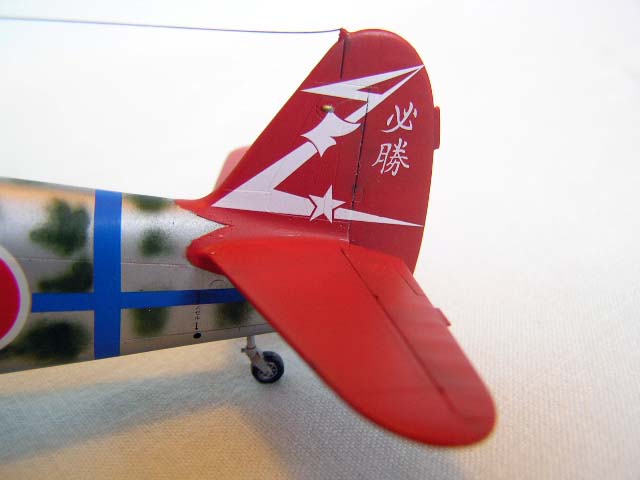
After the mottles were applied, with a Paasche VSR-90, some were
lightly polished and another gloss coat applied to even them out.
Weathering was achieved by applying a matt coat, which dulls the NMF
nicely, and some washes of highly diluted Burnt Umber. This was kept to
a minimum, given the VIP nature of this machine. Chipping of the
antiglare band was achieved by a very small amount of liquid mask
applied to the front and sides of it, and a bit of silver paint over
panel lines.
Decals
There is not much in the way of decals for your Hien. An old
Aeromaster sheet depicts several nice machines but most of them are
short-fuselage ones. The new sheets I have seen all depict 244th Sentai
machines. This Techmod sheet in particular is of the highest quality,
with colour instructions and including masks for the canopy, wheels and
tail (I had all those items already painted by the time it arrived!) and
lots of stencils, most of them over painted by the mottles. Three
machines, all flown by Kobayashi, are provided. My only complain is that
a bit of spare Blue strip should have been provided, to fix gaps. I had
to cover a pair of them, especially around the very problematical intake
area, and matching the colour is very difficult. The decals themselves
were really good, but a bit fragile.
This must be one of the sleekest, best looking Jap fighter planes.
The challenge of painting the mottles freehand over the NMF was enticing
and worth taking (I really did not dare do them, until circumstances
virtually forced me!). I would have loved to depict a (short fuselage?)
machine based at New Guinea; a friend of mine (an Aussie diplomat) told
me that some sizeable relics could still be seen around Port Moresby.
- “IJAAF Aces of WWII”, Osprey Publishing
- “WWII Japanese Aircraft Interior”, Robert Mikesh, Specialty Press
publishing.
- “Ki.61 Hien”, Aero Detail
Click on the thumbnails
below to view larger images:
[../../photogallery/photo00010299/real.htm]
Mode,
Text and Images Copyright © 2007 by Fernando Rolandelli
Page Created 25 June, 2007
Last Updated 24 December, 2007
Back to HyperScale
Main Page
|
Home
| What's New |
Features |
Gallery |
Reviews |
Reference |
Forum |